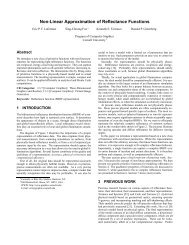pigmented colorants: dependence on media and time - Cornell ...
pigmented colorants: dependence on media and time - Cornell ...
pigmented colorants: dependence on media and time - Cornell ...
Create successful ePaper yourself
Turn your PDF publications into a flip-book with our unique Google optimized e-Paper software.
However, while the photographs are not completely physically accurate depicti<strong>on</strong>s<br />
of the actual color of the samples, they do give the viewer a reas<strong>on</strong>able subjective<br />
comparis<strong>on</strong>.<br />
An important observati<strong>on</strong> occurs when viewing the variati<strong>on</strong> in binding <strong>media</strong><br />
over the visible spectrum. Typically, the specific pigment determines the general<br />
shape of the spectral curve. That is, the intrinsic chemical properties of the ma-<br />
terial from which the pigment was created determines the central tendency of the<br />
material’s reflectance, as well as the wavelengths that are primarily absorbed. Yet,<br />
the specific binding <strong>media</strong> determines the exact behavior of how light behaves when<br />
striking the material. Each material has its own characteristics that it imparts <strong>and</strong><br />
<strong>on</strong>e recognizes these differences in a work of art. A painting in <strong>on</strong>e <strong>media</strong> will in-<br />
voke a different sensati<strong>on</strong> than that created in a different <strong>media</strong>. This relati<strong>on</strong>ship<br />
holds for all of the pigments in the study.<br />
This observati<strong>on</strong> is logical; as <strong>on</strong>e of the criteria for a binding material is that<br />
it does not drastically affect the materials that are suspended within it. An artist<br />
expects a pigment to maintain a relatively specific hue, whether it is dispersed<br />
in oil or watercolor or another <strong>media</strong>. However, as seen with Lapis Lazuli, while<br />
the general color is similar between binding <strong>media</strong>, there is great variati<strong>on</strong> in the<br />
resulting color between the different materials.<br />
A comm<strong>on</strong> way to compare colors is to transform them into a perceptually uni-<br />
form color space <strong>and</strong> study the results. This allows <strong>on</strong>e to quantify the magnitude<br />
of the difference between colors. In our case, this can be used to evaluate how<br />
much binding materials affect the color of a pigment.<br />
The basic computati<strong>on</strong> is to first c<strong>on</strong>vert the spectral data into CIE tristimulus<br />
169<br />
values XY Z. This is d<strong>on</strong>e using the resp<strong>on</strong>se matching functi<strong>on</strong>s, an illuminant



